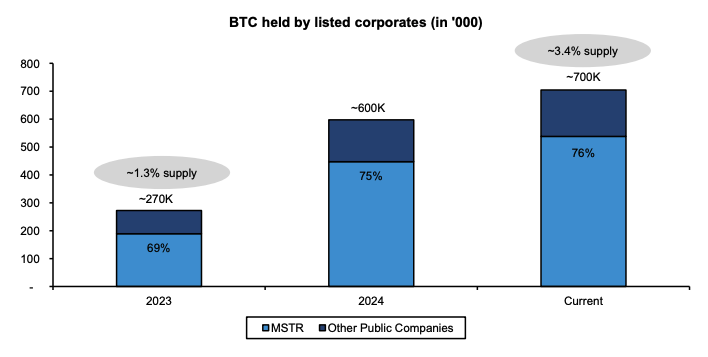Exploring the Current Bitcoin Market Dynamics: A Strong Case for New Highs
Bitcoin, often compared to gold and tech stocks, has seen fluctuating correlations throughout the year. Analysts at Bernstein highlight that short-term price movements can be misleading. Instead, major indicators such as retail selling exhaustion, corporate accumulation trends, and renewed ETF inflows are suggesting a potential "supply squeeze." This scenario could pave the way for Bitcoin to hit new all-time highs, as institutional interest continues to grow.
Corporate Ventures and Accumulation Strategies
Recent developments in the blockchain space have added fuel to the bullish case for Bitcoin. A consortium of high-profile players—including SoftBank, Tether, Bitfinex, and Cantor Fitzgerald—has launched a new initiative called Twenty One Capital. This corporate treasury venture anticipates a robust starting position of 42,000 BTC, funded by a mix of $900 million from SoftBank, $1.5 billion from Tether, and $600 million from Bitfinex. The goal is to merge with Cantor Equity Partners via a SPAC, raising an additional $585 million. Bernstein analysts noted that Twenty One seeks to replicate the success of other accumulation strategies while benefiting from substantial backing.
ETF Inflows and Institutional Interest
After a prolonged period of stabilization following Bitcoin’s dip to around $75,000, the market is witnessing a resurgence in ETF inflows. Last week alone, U.S. Bitcoin ETFs saw net inflows exceeding $3 billion, marking the highest in five months. Currently, Bitcoin trades near $95,295, with ETFs now holding more than 5.5% of Bitcoin’s total supply, translating to approximately $110 billion in assets under management. Notably, institutional investors have increased their share in ETF holdings, hinting at strategic portfolio allocations.
Rising Demand and Supply Dynamics
The combination of Bitcoin held by ETFs and corporate treasuries now constitutes nearly 9% of the total Bitcoin supply, a remarkable increase since the launch of ETFs in January 2024. Additionally, a recent executive order from President Trump to establish a U.S. Strategic Bitcoin Reserve indicates the potential for greater governmental engagement. According to Bernstein analysts, this could spur significant shifts in corporate and sovereign accumulation strategies, possibly pushing Bitcoin to unprecedented heights in 2025.
Exchange Balances and Supply Squeeze Indicators
Another compelling narrative comes from the declining Bitcoin balances on exchanges. Bernstein noted a drop from 16% at the end of 2023 to 13% currently, signaling a possible supply issue. While the overall dollar value of Bitcoin on exchanges has remained high due to price appreciation, the trend signifies a shift to more custodial arrangements, such as ETFs. Other analysts argue that this reflects a transformation in how Bitcoin is held rather than a diminishing supply.
Future Projections and Market Sentiments
Long-term forecasts from Bernstein paint a positive picture for Bitcoin. They anticipate a peak of around $200,000 by the end of 2025, potentially reaching $500,000 by 2029 and hitting $1 million by 2033. This optimism hinges on Bitcoin’s unique demand-supply dynamics and its fixed supply of 21 million coins. With nearly 19.9 million already mined and 95% of the remaining coins expected to be mined in the next decade, bearish sentiments seem increasingly unfounded.
Conclusion: Strong Fundamentals Amid Market Volatility
In summary, while Bitcoin has navigated a volatile market, the underlying fundamentals are robust. The current accumulation strategies from corporations and renewed institutional interest, combined with supply indicators, suggest a bullish outlook. As these factors continue to unfold, the cryptocurrency market remains poised for a transformative shift, with Bitcoin at the forefront. Whether through ETF growth, corporate treasury strategies, or potential government involvement, all signs point toward a powerful future for Bitcoin investors.


